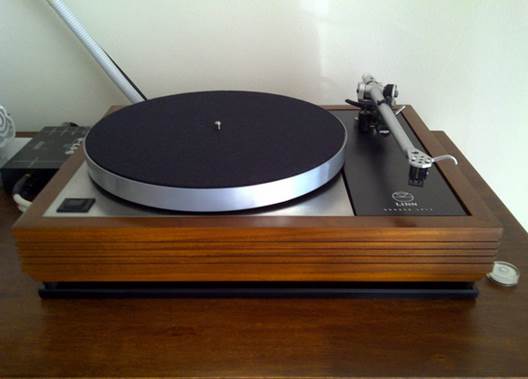We look back at what are surely one
of the most significant turntables releases ever and one that changed our
thinking – Linn’s loved and loathed Sondek LP12
In the great scheme of belt drive
turntables, the Sondek was an elegant evolution of thinking first seen in the
original AR deck, and crystallized in the Thorens TD150 – offering a precision
of construction and attention to detail that few have matched since its launch
back in 1973. Devoid of fripperies or gimmickry, the straight-laced LP12
introduced little that was radical in design terms. Rather, it was simply
engineering ‘best practice’ of the day done to painstakingly high standards,
with a patented ‘single-point’ bearing. Despite this, it went on to forge out
an entirely new role for the hi-fi turntable in general, thanks to its own and
its creator’s special endeavors.
By the late seventies the Sondek had
already become the personification of the belt drive ‘super deck’, and by the
early nineties it was surely the most famous hi-fi turntable in the world.

By
modern standards the Sondek’s overall tonal character was very warm
At the time of its inception, lest we
forget, almost no one in the hi-fi firmament took seriously the idea that the
source was the most important link in the hi-fi chain. And so it fell to a
young Ivor Tiefenbrun to drive the point home, but it wasn’t just his obvious
erudition that popularized the idea of ‘garbage in, garbage out’, it was
because he was absolutely correct in what he said.
You spin me round...
Earlier generations of Hi-Fi writers had
assumed that turntables needed to do nothing apart from revolve at the right
speed in a quiet and stable way. Linn showed that more was needed, not least to
be able to present a high precision closed loop between the turntable and
tonearm in order for the cartridge to do its job.
This done, the deck would provide a
high-quality signal with which the subsequent links in the system chain would
work to make a great sound. If the source wasn’t up to scratch, Ivor would
constantly tell anyone who’d listen, the speakers couldn’t make up for it
later. This reasoning now seems such a ‘no-brainer’ that it’s hard to
appreciate that 40 years ago it was heresy to a great many people – especially
loudspeaker manufacturers!

The
above is the latest addition to my music playback system – a 30 years old Linn
Sondek LP12 turntable bearing serial number 35xxx fitted with Rega RB700
tonearm
Interestingly and importantly, however,
Tiefenbrun didn’t abandon his prized LP12 while building up his company’s
product portfolio; the deck received a series of upgrades which showed that
Linn took the sonics of the deck extremely seriously. It was this rolling
improvement programmer which was to make the deck so enduring. An original
early seventies sample sounds different to the latest build – yet curiously
somehow similar. As such, many myths and legends have grown up around the LP12.
The Sondek is an independently sprung
sub-chassis design, originally with an AC synchronous motor driving a heavy
mazak (alloy) platter, sitting atop a machined inner platter which in turn
rests on a custom, high-quality bearing. The bearing is set into a sub-chassis,
which rests on three springs that can be adjusted for height and bounce. The
sub-chassis also hold the arm board, which Linn supplies in a variety of
guises; the original boards were painted MDF. Around all this is a veneered
wood plinth; earlier Sondeks for many years came in Afromosia – a type of
African rosewood although Black Ash was available.
In its original 1973 guise complete with
smoked dustcover – the Sondek was a sumptuous-sounding device with a big, fat
bass and sugary sweet mid-band. Treble was silky and soft, which meant the
deck’s overall tonal character was very warm by modern standards – and indeed
those of the current production LP12. What really impressed was the sense of
rhythms that the turntable served up; it seemed better able to extract the
‘groove’ from music than practically any other deck on the market back then.
This made it wonderfully entertaining to listen to and its superiority over
rivals made some believe it had a magic quality to it.
The Sondek was a sumptuous sounding
device with a big, fat bass and sugary sweet mid-band

The
Sondek was a sumptuous sounding device with a big, fat bass and sugary sweet
mid-band
Over the course of the decade a few changes
were made – mostly in 1974 (from serial number 2000), with new main bearing
liner material, a strengthened sub-chassis, a modified motor control printed
circuit board and a different mains switch fitted. Then in 1979 the deck got
more elegant spring-loaded lid hinges, but it wasn’t until 1981 (at 27,000)
that the deck really got its first major mod – one which Linn decided to give a
name. The much-acclaimed Nirvana spring and motor mod kit (from 32,826) gave a
tighter and gripper sound, which stripped the deck of a lot of its bass
overhang and syrupy warmth. Then Linn announced the Valhalla crystal-driven
power supply board (38,794), which gave a profound improvement to the overall
clarity and detail of the sound, again making it sound leaner although it was
still miles away from the (then) new Compact Disc.